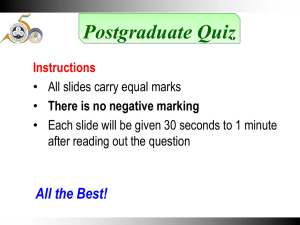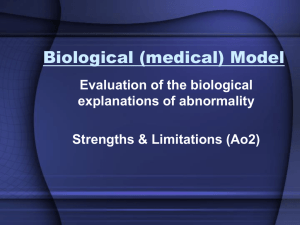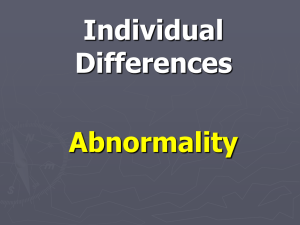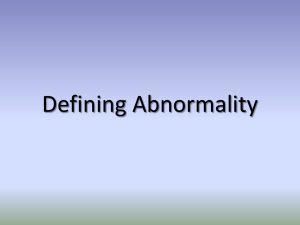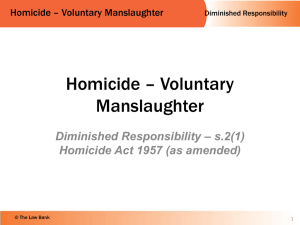Diminished Responsibility- new law
advertisement
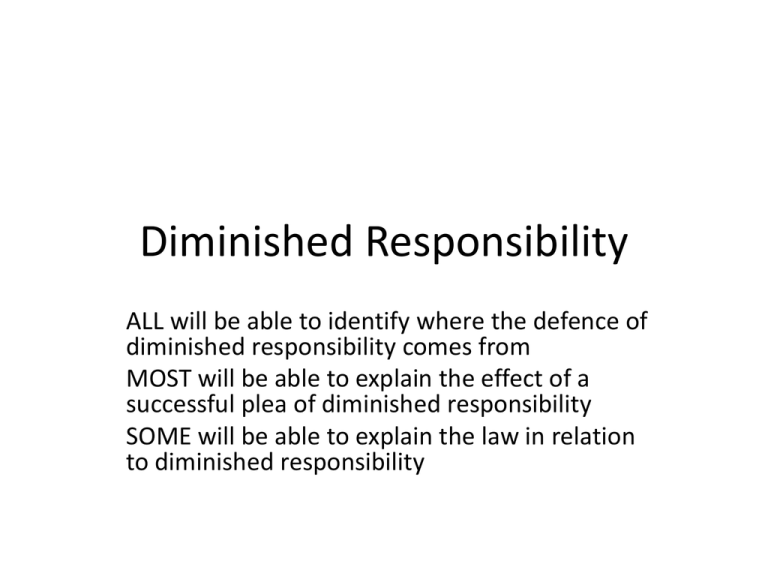
Diminished Responsibility ALL will be able to identify where the defence of diminished responsibility comes from MOST will be able to explain the effect of a successful plea of diminished responsibility SOME will be able to explain the law in relation to diminished responsibility What is voluntary manslaughter? • Voluntary Manslaughter is where the Defendant has committed murder, but raises a special (partial) defence which justifies a lesser sentence (and avoids mandatory life). • D is not acquitted if successful in raising this defence. • The judge can issue any sentence they feel appropriate (up to life imprisonment) • There are only one of three circumstances where D can raise a special defence: – Diminished Responsibility – Loss of Control – Suicide Pact (not studied in the course) • It is a special defence because it can only be used where D is charged with murder. TASK 1 a. What is voluntary manslaughter? b. What is the effect of a successful plea of voluntary manslaughter? c. What three circumstances may a defendant use for voluntary manslaugter? d. What is a special defence? Diminished Responsibility • Introduced by Homicide Act 1957 and amended by Coroners and Justice Act 2009– previously if a person with mental problems killed, only defence insanity. • Definition is set out in S2 Homicide Act 1957 as amended by S52 Coroners & Justice Act 2009 and requires the defendant to prove (on a balance of probabilities): 1. D was suffering from abnormality of mental functioning 2. Which is due to recognised medical condition 3. Which substantially impairs D’s ability to understand nature of conduct OR form rational judgment OR exercise self control 4. The abnormality provides explanation for D causing V’s death : causal link between medical condition & killing TASK 2 a. Where does the authority for diminished responsibility come from? b. Who has to prove the defence? c. What standard does this burden have to be proven by? d. What 4 things must be proven for diminished responsibility to be successful? What is Abnormality of Mental Functioning? • objective view of what is ‘abnormal’: reasonable man’s view • TEST for abnormality of mental functioning: ‘state of mind so different from that of ordinary people that the reasonable person would term it abnormal’ – R v Byrne [1960]. Although this case uses the old test, it’s likely the courts will use this definition. TASK 3 a. What does ‘abnormality of mental functioning’ mean? Use case authority! Cause of abnormality of mental functioning • Such inability must be due to a recognised medical condition • Does not have to be permanent, but must exist at time of killing • Case examples pre-amended defence: • psychopath: R v Byrne (1960) • depression: R v Seers (1984) • Battered Woman Syndrome: R v Ahluwalia (1992) • NB: Can be induced by disease or injury BUT NOT INTOXICATION, UNLESS reached state where Brain has been injured – drinking involuntary – R v Tandy (1989) CA • However, CA recently shown more sympathy for D’s who kill while suffering from ADS: alcohol dependence Syndrome : R v Wood [2003] – no longer prove brain damage – up to jury to decide if alcoholism substantially impaired D’s ability … & that D’s alcohol consumption directly resulted from ADS. NB: There must be medical evidence at the trial to prove abnormality of mental functioning. Task 4 a. What must cause the abnormality of mental functioning? b. Give some examples of abnormality of mental functioning. c. What evidence must be provided in order to prove this? d. Using the case of Stewart (James) (2009) explain the guidelines for diminished Responsibility and alcohol dependency syndrome. Abnormality must substantially impair D’s acts or omissions • i.e. D must not be able to understand the consequences of his actions/find it difficult to rationalise/have self control due to his abnormality of the mind. • To what degree (must be substantial) is a Q for the jury to decide: Lloyd (1967) – does not mean total, nor does it mean minimal; something in between. What must be substantially impaired? D must do 1 of 3 things in order for the jury to consider him to be substantially impaired: • D must not be able to understand nature of conduct – includes situations where D doesn’t know what he is doing e.g. automatic state. • OR form rational judgment (whether act is right or wrong) • OR exercise self control – e.g. Byrne (was unable to control perverted desires) Task 5 a. The abnormality of mental functioning must substantially impair D’s acts or omissions. What three ways may D be substantially impaired? b. What does ‘substantial impairment’ mean? The abnormality must provide an explanation for D’s conduct • Is it the CAUSE or SIGNIFICANT CONTRIBUTING FACTOR in causing D to carry out his conduct which killed V? • E.g. Is there a causal link between the medical condition & the killing? • NB: Abnormality of the mind need not be the only factor that caused D to be involved in the killing but it must be the significant factor. Abnormality of mental functioning and intoxication • Was D intoxicated at the time of the killing? If so, D’s abnormality of mental functioning must be a significant factor in causing the victims death. It is irrelevant if he was intoxicated: (Dietschmann). • NB: Drinking/taking drugs is not a medical condition even if it has an effect on the brain unless it creates a recognised abnormality of mental functioning: Di Duca • However where D suffering from alcoholism (and the alcoholism was a significant factor in causing V’s death) this would be considered an abnormality of mental functioning: Wood (2008) How has the law been reformed? • Defence recently updated to deal with many of the previous problems identified by the Law Commission report Murder, Manslaughter and Infanticide (2006): • Allows for developments in medical science by allowing the phrase ‘recognised medical condition’ • The new act also sets out what must be substantially impaired whereas the old one didn’t. i.e. D must not be able to understand the nature of his conduct; to form a rational judgement or exercise self control. Diminished responsibility under s52 CJA 2009 Evaluation of this change – the following differences apply: • Whereas previously there needed to be an abnormality of the mind there now needs to be an abnormality of mental functioning • Whereas previously the abnormality needed to have substantially impaired his mental responsibility for his actions now this needs to have substantially impaired the D’s ability to either understand the nature of his conduct, to form a rational judgment or to exercise self-control and this provides an explanation in respect of the killing • Are there any problems that still exist? • Yes! • Nearly every other defence raised by D has to be disproved by the Pros. For DR D raises but has to prove it. This conflicts with article 6 ECHR (innocent until proven guilty). • This can also be difficult for jurors to understand as many D’s will run two defences at once and will have different burdens for the jury to consider. • Medical evidence shows that the frontal lobes of the brain (responsible for self-control) do not develop until 14, which conflicts with the age of criminal responsibility as developmental maturity is not the same as a learning disability and may not fall within the ‘recognised medical condition’ criteria for mental functioning. What is the effect of a successful plea of diminished responsibility? What are the current problems with the law on diminished responsibility? Who does the burden rest with? By what standard does the burden have to be proven? If D is intoxicated at the time of the killing, what must be proven (refer to legal authority)? What is the test for abnormality of mental functioning? Byrne (1960_ DIMINISHED RESPONSIBILITY Causation needs to be satisfied. What needs to be established for this to be proven? Definition comes from? by What 4 things must be proven ? 1. as amended What evidence needs to be obtained in order for mental functioning to be proven? 2. 3. 4. What does substantially impair mean refer to authority? What one of three things would constitute substantial impairment? Where D doesn’t… Give some examples of what would constitute abnormality of mental functioning with supporting authority. 1. 2. 3. Does the abnormality of mental functioning need to be permanent? Whether D is substantially impaired is a question for who to decide?
